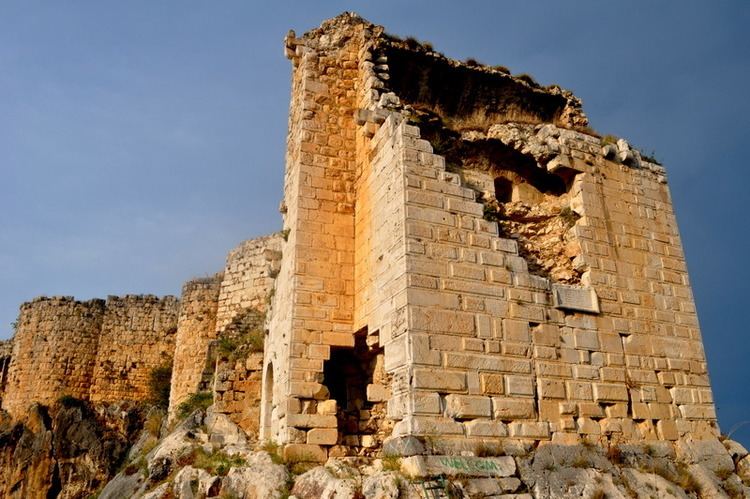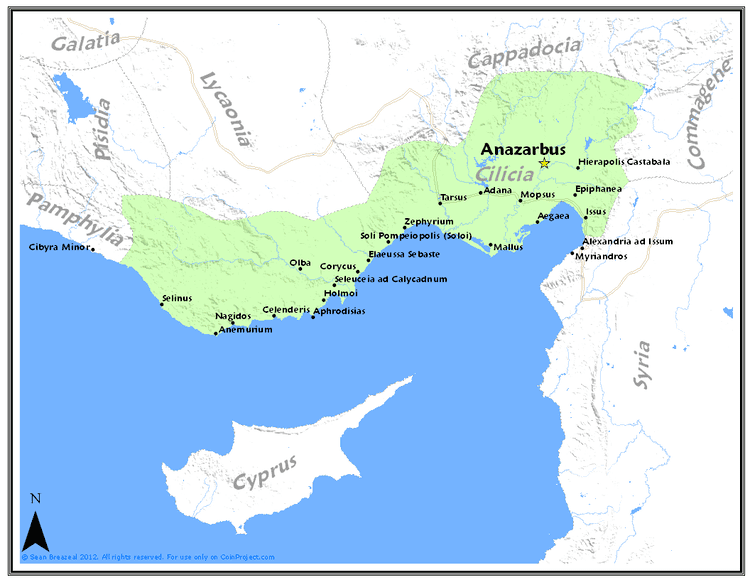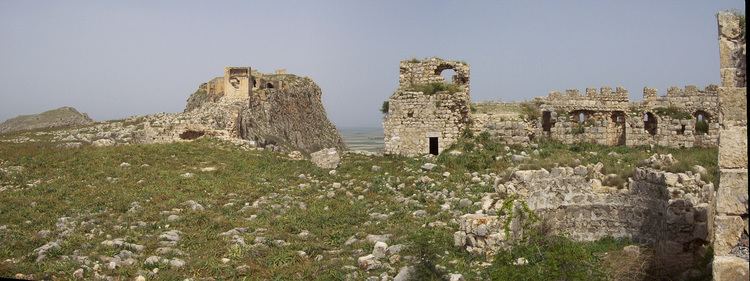Alternate name Caesarea, Justinopolis Type Settlement | Location Adana Province, Turkey Region Cilicia | |
 | ||
Anavarza anazarbus caesarea kozan adana turkiye
Anazarbus (Ancient Greek: Ἀναζαρβός, medieval Ain Zarba; modern Anavarza) was an ancient Cilician city and (arch)bishopric, which remains a Latin Catholic Titular See.
Contents
- Anavarza anazarbus caesarea kozan adana turkiye
- historical armenia anazarbus anavarza
- Location
- History
- Remains
- Ecclesiastical history
- Titular Latin see
- Titular Armenian see
- Notable locals
- References

historical armenia anazarbus anavarza
Location

It was situated in Anatolia in modern Turkey, in the present Çukurova (or classical Aleian plain) about 15 km west of the main stream of the present Ceyhan River (or classical Pyramus river) and near its tributary the Sempas Su.
A lofty isolated ridge formed its acropolis. Though some of the masonry in the ruins is certainly pre-Roman, the Suda's identification of it with Cyinda, famous as a treasure city in the wars of Eumenes of Cardia, cannot be accepted in the face of Strabo's express location of Cyinda in western Cilicia.
History

It was founded by Assyrians. Under the early Roman empire the place was known as Caesarea, and was the Metropolis (capital) of Late Roman province Cilicia Secunda. It was the home of the poet Oppian.

Rebuilt by the Byzantine emperor Justin I after an earthquake in the 6th century, it became Justinopolis (525); but the old native name persisted, and when Thoros I, king of Lesser Armenia, made it his capital early in the 12th century, it was known as Anazarva.
Remains
Its great natural strength and situation, not far from the mouth of the Sis pass, and near the great road which debouched from the Cilician Gates, made Anazarbus play a considerable part in the struggles between the Byzantine Empire and the early Muslim invaders. It had been rebuilt by Harun al-Rashid in 796, refortified at great expense by the Hamdanid Sayf al-Dawla (mid-10th century) and again destroyed in 962 by Nikephoros II Phokas.
In late 1097 or early 1098 it was captured by the armies of the First Crusade and was incorporated into Bohemond’s Principality of Antioch. The Crusaders are probably responsible for the construction of an impressive donjon atop the center of the outcrop. Most of the remaining fortifications, including the curtain walls, massive horse-shaped towers, undercrofts, cisterns, and free-standing structures date from the Armenian periods of occupation, which began with the arrival of the Rubenid Baron T‛oros I, ca. 1111. The site briefly exchanged hands between the Greeks and Armenians, until it was formally part of the Armenian Kingdom of Cilicia. Within the fortress are two Armenian chapels and the magnificent (but severely damaged) three-aisle church built by T‛oros I to celebrate his conquests. The church was once surrounded by a continuous, well-executed dedicatory inscription in Armenian.
The Mamluk Empire of Egypt finally destroyed the city in 1374.
The present wall of the lower city is of late construction. It encloses a mass of ruins conspicuous in which are a fine triumphal arch, the colonnades of two streets, a gymnasium, etc. A stadium and a theatre lie outside the walls to the south. The remains of the acropolis fortifications are very interesting, including roads and ditches hewn in the rock. There are no notable structures in the upper town. For picturesqueness the site is not equaled in Cilicia, and it is worthwhile to trace the three fine aqueducts to their sources. A necropolis on the escarpment to the south of the curtain wall can also be seen complete with signs of illegal modern excavations.
A visit in December 2002 showed that the three aqueducts mentioned above have been nearly completely destroyed. Only small, isolated sections are left standing with the largest portion lying in a pile of rubble that stretches the length of where the aqueducts once stood. A powerful earthquake that struck the area in 1945 is thought to be responsible for the destruction.
A modest Turkish farming village (Dilekkaya) lies to the southwest of the ancient city. A small outdoor museum with some of the artifacts collected in the area can be viewed for a small fee. Also nearby are some beautiful mosaics discovered in a farmers field. Inquire at the museum for a viewing.
Anazarbus/Anavarsa was one of a chain of Armenian fortifications stretching through Cilicia. The castle of Sis (modern Kozan, Adana) lies to the north while Tumlu Castle and Yilankale are to the south, and the fortresses of Amouda and Sarvandikar are to the east.
Ecclesiastical history
Anazarbus was the capital and so also from 553 (the date of the Second Council of Constantinople) the metropolitan see of the Late Roman province of Cilicia Secunda.
A 6th century Notitia Episcopatuum indicates that it had as suffragan sees Epiphania, Alexandria Minor, Irenopolis, Flavias, Castabala and Aegeae. Rhosus was also subject to Anazarbus, but after the 6th century was made exempt, and Mopsuestia was raised to the rank of autcephalous metropolitan see, though without suffragans.
It faded, but got two Catholic titular successor sees.
Titular Latin see
The archdiocese was nominally restored in the 18th century, when was established a Latin Catholic Metropolitan Titular archbishopric of Anazarbus.
It is vacant, having had the following incumbents, generally of the highest (Metropolitan) rank, with an episcopal (lowest rank) exception :
Titular Armenian see
In the 19th century, an Armenian Catholic titular bishopric of Anazarbus (of the Armenians) (Anazarbus degli Armeniin Curiate Italian) was established.
It was a suppressed in 1933, having had a single incumbent, of the intermediary (archiepiscopal) rank :
